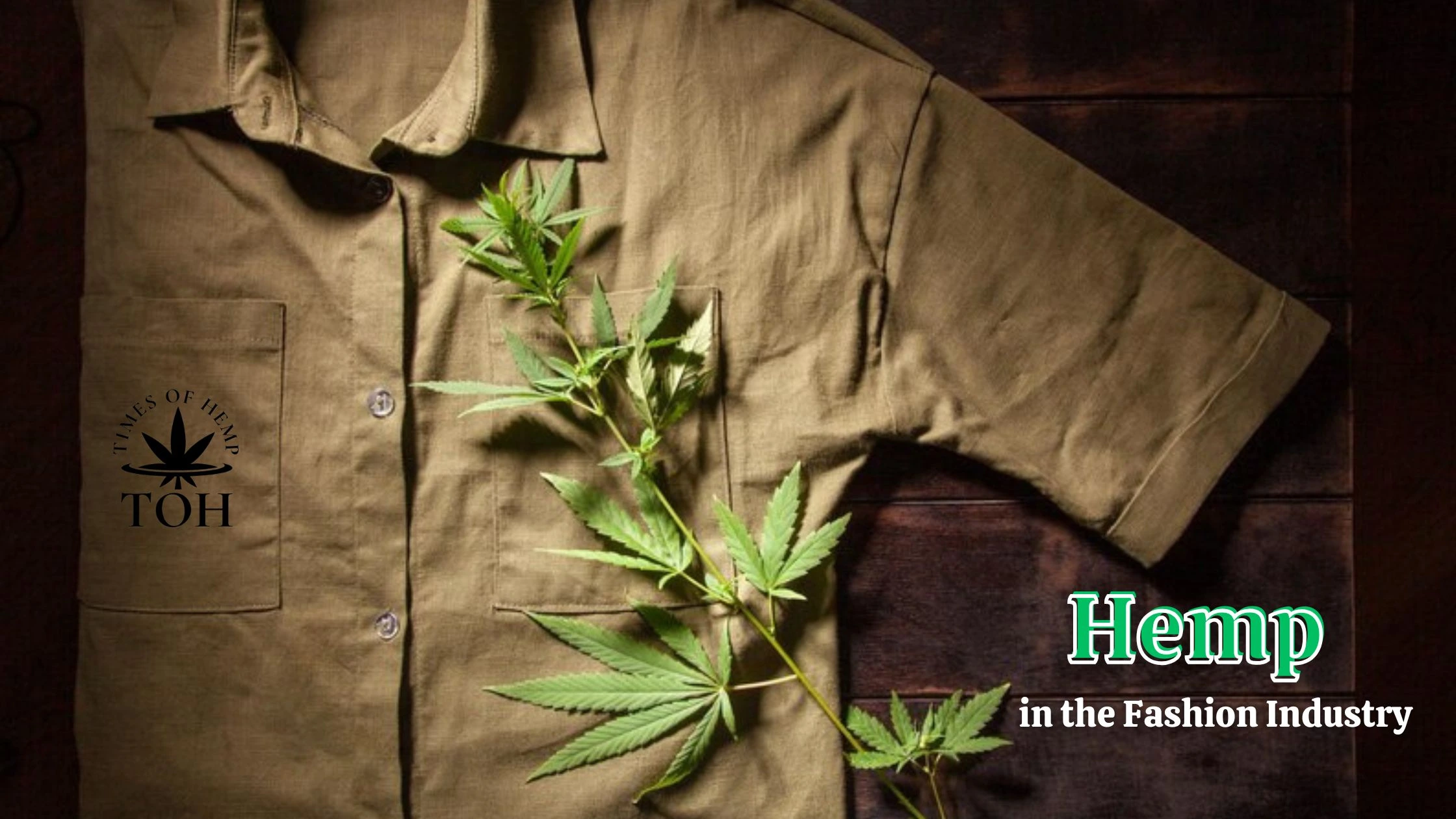The world of fashion is changing, and it’s greener than ever. As consumers, we’re growing increasingly aware of the impact our choices have on the planet, and we’re seeing a trend towards more sustainable materials and practices in the fashion industry. Among these eco-friendly alternatives, one material stands out for all the right reasons—hemp.
But what exactly is hemp, and how did it become one of fashion’s hottest sustainable choices? Today let’s dive with Times of Hemp into how hemp is transforming the fashion industry, from its roots as a versatile plant to its presence on eco-conscious runways.
What is Hemp?
Hemp, a variety of the Cannabis sativa plant, has been cultivated for thousands of years for various purposes. Unlike its psychoactive cousin marijuana, industrial hemp contains only trace amounts of THC, the compound that creates a “high.” Instead, hemp’s main attractions lie in its durability, versatility, and eco-friendliness. This plant can be turned into a wide range of products—from food and skincare to paper and textiles.
What sets hemp apart as a sustainable choice is its environmental footprint. It’s a low-maintenance crop that grows quickly with minimal water and no need for chemical pesticides or herbicides. Additionally, hemp roots stabilize soil and prevent erosion, contributing to healthier land. When we think about the toll traditional cotton farming takes on the environment, it’s easy to see why hemp is gaining traction. When we think about the toll traditional cotton farming takes on the environment, it’s easy to see why hemp is gaining traction.
The Journey of Hemp from Plant to Fabric
The procedure of “retting,” which involves soaking the stalks to soften and separate the fibers, is used to create hemp fabric. The fibers are spun into a thread after retting, which can subsequently be woven into fabric. The outcome? A resilient and adaptable fabric that is renowned for its breathability and durability.
Although hemp fabric has a rustic texture by nature, it may be softened to produce a variety of textures to meet different fashion needs. Depending on the finishing technique, hemp can resemble cotton or linen in appearance and texture, which makes it appropriate for everything from casual clothing to expensive fashion items.
Why Hemp is a Sustainable Superstar
Hemp’s environmental friendliness is one of its main appeals. Let’s examine the factors that make it a more environmentally friendly option than conventional textiles:
1. Minimal Use of Water
Compared to cotton, hemp requires a lot less water to grow. Hemp’s low water requirements make it a game-changer in a world where water scarcity is becoming an urgent problem. For instance, hemp uses a fraction of the water needed to manufacture 1 kg of cloth, but cotton might use up to 20,000 litres.
2. No Need for Pesticides or Herbicides
Because hemp grows faster than weeds and is naturally pest-resistant, harmful pesticides are unnecessary. This benefits the environment and the local communities and farmers who work with the crops.
3. Sequestration of Carbon
More CO2 is absorbed from the atmosphere by hemp than by many other plants since it is a strong carbon sink. Amazingly, a single hectare of hemp can absorb almost 8 to 22 tons of CO2 a year.
4. Biodegradable
Because hemp clothing is biodegradable, it can be composted instead of ending up in a landfill when it does finally wear out.
The Benefits of Wearing Hemp
In addition to being sustainable, hemp offers several other advantages that make it a great fabric for apparel. You might want to include a few hemp-related things in your wardrobe for the following reasons:
1. Durability
The strength of hemp cloth is well known; some claim it is three times stronger than cotton. As a result, there is less need to acquire new garments as often because hemp clothing may last.
2. Comfortability and Breathability
Because hemp fabric naturally breathes, it keeps you warm in the winter and cool in the summer. Additionally, it wicks away moisture, which makes it perfect for hot weather or activewear.
3. Hypoallergenic and Anti-Bacterial
For people with sensitive skin or allergies, hemp fibers are excellent since they are resistant to bacteria and mold. Because hemp naturally doesn’t smell, it also keeps clothes fresher for longer.
4. Gets Softer After Every Wash
Despite first seeming harsh, hemp cloth softens with each wash and time, providing comfort and durability.
You can also read about the diverse range of benefits of hemp, apart from the clothing benefits, in our other article, click here:- The Sustainability of Hemp
Hemp Fashion on the Rise: A Growing Trend
It wasn’t long ago that the fashion industry was hesitant to embrace hemp. But as the market for eco-friendly clothing expanded, companies started looking into the possibilities of hemp. Designers from all around the world are including it in their creations now that it has become popular. Hemp is appearing in every sector of the fashion business, from high-end fashion houses to streetwear companies.
Hemp has long been incorporated into the designs of well-known eco-conscious brands like Stella McCartney and Patagonia, but now smaller, independent designers are also joining the trend. A movement in consumer preferences toward transparency is contributing to this trend. Many people who care about fashion are curious about the origins of their clothing and are willing to support companies that prioritize sustainability.
The Challenges of Hemp in Fashion
Although hemp has many benefits, there are drawbacks as well. The price is one of the biggest obstacles. The fabric may cost more because hemp cultivation and processing are not as well-established as cotton. It can also be challenging to source because hemp is still subject to stringent laws in some nations because of its connection to marijuana.
Additionally, some people may find hemp’s texture unappealing. Some individuals find it stiff or abrasive at first, but it does soften with time. In order to overcome this, producers frequently combine hemp with other materials, such as recycled polyester or organic cotton, to produce a softer and more adaptable fabric.
Why Choose Hemp for Your Wardrobe?
Hemp is a great choice if you want your fashion decisions to have a sustainable influence. You’re helping a crop that uses less resources, is better for the environment, and improves soil health by wearing hemp apparel. Additionally, because hemp is long-lasting, purchasing a few high-quality hemp items may result in fewer journeys to the shop for replacements, which would ultimately save money and reduce waste.
Including hemp items in your collection is a commitment to sustainability and a more promising future for fashion, not just personal taste.
Hemp’s Future in the Fashion World
Hemp has a huge potential for fashion possibilities. More companies are probably going to use sustainable textiles like hemp as consumers become more conscious of the negative effects rapid fashion has on the environment. Researchers are investigating novel methods of processing hemp to make it even softer and more adaptable, which is another fascinating breakthrough taking place in the textile sector.
We may anticipate seeing hemp utilized in an even greater variety of apparel items as it becomes more widely available and reasonably priced. Activewear, loungewear, and even formal wear made of hemp may soon become popular, making it simpler than ever to select eco-friendly solutions without compromising elegance.
Making the Shift to a Hemp-Infused Wardrobe
So, how can you start incorporating hemp into your wardrobe? Seek out brands that emphasize ethical production methods and sustainable resources. Nowadays, a lot of environmentally concerned-brands use hemp in their collections, which range from skirts and coats to T-shirts and trousers. Don’t worry if you’re on a tight budget; you don’t need to change your entire wardrobe all at once. Build from the ground up, starting with a few basic components.
The fashion industry is at last realizing that maintaining a stylish appearance should not come at the expense of the environment. With its long history and indisputable advantages, hemp is a major contributor to the movement toward a more sustainable and greener future.
So next time you’re out shopping or scrolling through your favorite online store, consider giving hemp a try. Who knows? You might just fall in love with the fabric of the future.






The post is so so informative. Thanks for the post.